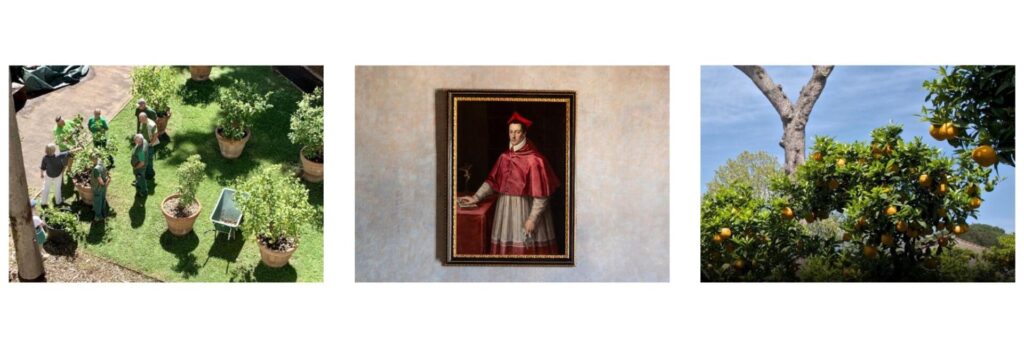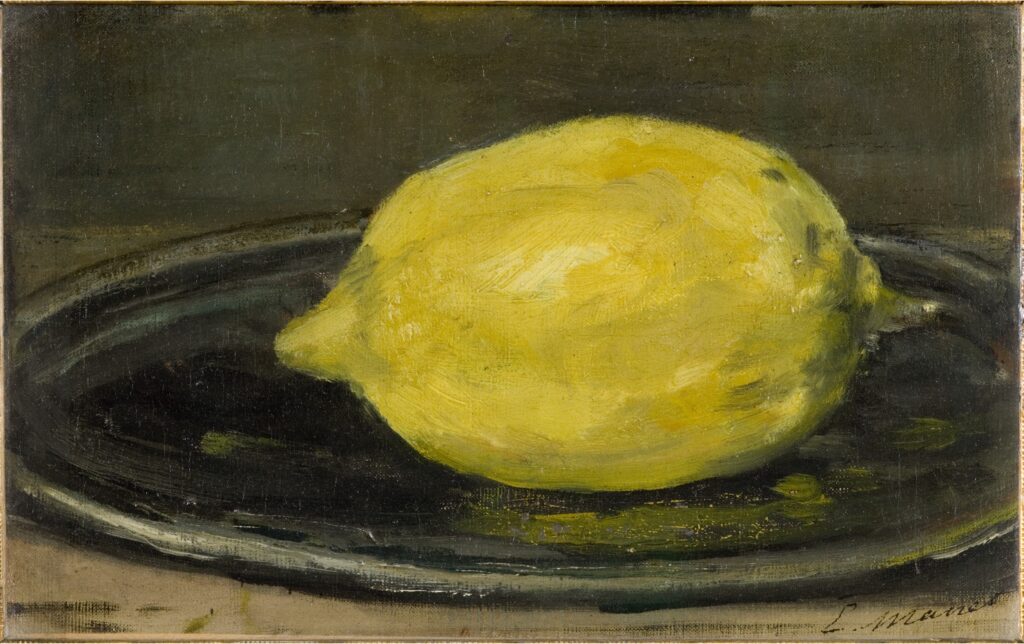
Exhibition | Le Citron by Édouard Manet : from the musée d’Orsay to Villa Medici
March 1 to May 19, 2024
Exceptional loan from the musée d’Orsay, as part of the french event “Les 150 ans de l’impressionnisme » (150 years of Impressionism).
The painting is on display in the historic bedroom of Cardinal Ferdinand de’ Medici, accessible only on guided tours of Villa Medici.
An iconic citrus fruit of the Mediterranean landscape, the lemon is featured in Villa Medici’s spring program thanks to the exceptional loan from the musée d’Orsay of the work Le Citron (The Lemon) painted by Edouard Manet in 1880, exhibited for three months in the Cardinal de’ Medici’s historic rooms, the highlight of the guided tour of Villa Medici.

From Ferdinando de’ Medici to Edouard Manet: The Lemon, the Object of All Passions
In the 16th century, orange, lemon, sour orange, and citron trees were abundant in the vast garden of the estate acquired by Ferdinando I de’ Medici in 1576. Carefully tended by gardeners to preserve their size and flavor, citrus fruits supplied Ferdinando I de’ Medici’s table, while their blossoms and peels could be candied, pickled, or transformed into fragrant oils and distilled in the palace’s fonderia. In particular, the citron, or mala medica, was cultivated for its pharmacological virtues: it relieved fevers and could neutralize poisons. Today, visitors to Villa Medici are reminded of the precious citrus fruit when they contemplate the painted vault of the stanza degli uccelli (“bird room”), Ferdinando’s private study.
Édouard Manet, Le Citron (The Lemon), 1880, oil on canvas, 14 x 22 cm. Paris, Musée d’Orsay. Bequest of Count Isaac de Camondo, 1911 © Musée d’Orsay, Dist. RMN-Grand Palais / Patrice Schmidt
From Rome to Paris, from one citrus passion to another: three centuries after the birth of Ferdinando I de’ Medici’s fruit collection, Edouard Manet (Paris, 1832-1883) painted Le Citron. Despite its modest size (14 x 22 cm), this painting is one of the powerful still lifes by the painter who claimed to be the “Saint Francis of the still life.” Here, the painter has isolated the yellow-hued fruit on a sober, black-glazed ceramic saucer that brings out the essential: its strident color, texture, and simplicity.




150 YEARS OF IMPRESSIONISM
In 2024, the French Ministry of Culture and the musée d’Orsay will be celebrating 150 years of Impressionism. In conjunction with the exhibition Paris 1874. Inventer l’impressionnisme (Paris 1874: Inventing Impressionism), to be held in Paris, some 180 works exceptionally loaned by the musée d’Orsay are to be discovered in over 30 museums in France. Manet’s Le Citron will thus be in the spotlight at Villa Medici, forging a link with the Medici family’s passion for citrus fruit.
→ Press release “Les 150 ans de l’impressionnisme avec le musée d’Orsay”
VINCIANE DESPRET, WRITING IN RESIDENCE AT THE VILLA MÉDICIS
The silent presence of the Lemon at Villa Medici, which seems to summon all the senses, will be part of a writing residency in April by French author and philosopher Vinciane Despret in pursuit of what the fruit may reveal.

Vinciane Despret is a philosopher, psychologist and professor at the University of Liège in Belgium. After discovering the work of ethologists, she turned her attention to the philosophy of science. Examining and questioning our relationship with animals is at the heart of her work.
Her many publications include Quand le loup habitera avec l’agneau (When the Wolf Also Shall Dwell with the Lamb, 2004), Penser comme un rat (To Think Like a Rat, 2009), Le Chez-Soi des animaux (The Animals’ Home, 2017), Que diraient les animaux… si on leur posait les bonnes questions ? (What Would Animals Say If We Asked the Right Questions?, 2018) and Habiter en oiseau (Living as a Bird, 2019). Vinciane Despret has joined forces with Bento Architects to curate Belgium’s pavilion at the 2023 Venice Architecture Biennale. Portrait of Vinciane Despret by Sylvère Petit.
En mai 2023, à l’occasion de la parution en Italie du livre Autobiographie d’un poulpe, Vinciane Despret a proposé une rencontre à la Villa Médicis avec Emanuele Coccia et Paolo Pecere au sujet de l’environnement, du rapport entre les espèces vivantes et de l’architecture à la Villa Médicis. Cet échange s’inscrivait également comme un prélude à la troisième édition du Festival des Cabanes de la Villa Médicis.
In May 2023, to mark the publication in Italy of the book Autobiographie d’un poulpe (Autobiography of an Octopus), Vinciane Despret invited Emanuele Coccia and Paolo Pecere to Villa Medici to talk about the environment, the relationship between living species and architecture at Villa Medici. This exchange was also a prelude to the third edition of the Festival des Cabanes at Villa Medici.
ACKNOWLEDGMENTS
Villa Medici’s citrus programming is supported by the Fondation Gerard B. Lambert, Amundi, and Van Cleef & Arpels.
The exhibition of Manet’s Le Citron at Villa Medici is made possible thanks to an exceptional loan from the musée d’Orsay.
PHOTO CREDITS
Cover image : détail, Édouard Manet, Le Citron, 1880, oil on canvas, 14 x 22 cm. Paris, musée d’Orsay. Legs comte Isaac de Camando, 1911. © Musée d’Orsay, Dist.
Photos © Daniele Molajoli
Lemon’s garden ©AFR
Portrait of Ferdinando di Medici by Jacopo Zucchi © Daniele Molajoli
Garden of Villa Medici © AFR
Portrait of Vinciane Despret © Sylvère Petit



